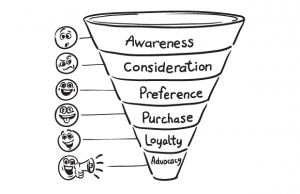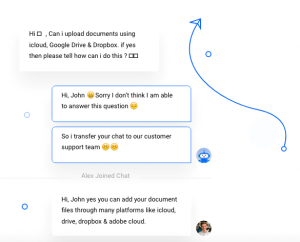Do you receive a lot of traffic on your website? That’s great. But how many of these visitors end up buying something on your site? High traffic but a low conversion rate is a problem faced by many organizations. However, it is an easy problem to fix if you invest in the right technology to give your customers what they want – a great experience.
But what constitutes a great experience remains a mystery for most businesses who are grappling in the dark to satisfy their customers’ needs without even knowing what they want.
According to Walkers, an immediate resolution would no longer be enough for customers in 2020. They will demand a higher degree of Personalization and expect companies to anticipate and proactively address their current and future needs.
In short – faster and efficient customer service will not be enough to satisfy your customers in the future. Fortunately, it is possible to make your customer service not only speedy and cost-effective but also intuitive with the help of an AI-enabled chatbot. No wonder – the use of chatbots in the customer service industry is growing.
According to data, 85% of all customer service interactions would be handled without a human agent by 2020. The reason is simple. Using chatbots for customer support has several advantages, such as saving up to 30% of the costs and speeding up the response times by answering 80% of routine questions.
Chatbots also impact your bottom line by improving your conversion rate when used correctly. For example, chatbots offer 24/7 support on your site, which makes it possible to provide personalized support whenever a customer interacts with any of your engagement channels. You can also use bots to answer all the basic questions so that only the customers with pressing requirements are passed on to live agents.
Here are seven ways to convert your visitors to customers using a chatbot:
Enable Real-Time Support
25% of customer service and support operations will integrate a virtual customer assistant or chatbot technology across channels by 2020. In another two years, bots are expected to save businesses $8 billion per year.
The reason is simple. According to research, 82% of buyers demand an instant answer to their questions, allowing businesses a response rate of fewer than 10 minutes.
The rise of AI-enabled chatbot has made it possible for companies to offer real-time support to their customers on multiple platforms, ensuring higher customer satisfaction rates. With AI technology, not only can bots handle higher volumes of interactions in a given span but also respond intelligently to questions, facilitating two-way digital conversations. Also, the chatbot can instantly handle up to 80% of customer queries by leveraging Machine Learning to interpret inquiries and learn from new experiences.
Set Relevant Triggers
It is common for users to browse a website and then close the tab or move on to something else. This gives you only a few seconds to grab the attention of your visitors and turn them into loyal customers. But how do you best use this time to your advantage?
By positioning your chatbot on different pages at the right locations, you can engage your visitors with personalized suggestions and offers while they are viewing items on your site. For example, if a user is looking for shoes on your website, the bot could ask relevant questions to learn more about their preferences while they are browsing.
However, remember that you don’t want to be too nosy or spammy. Several websites repeatedly bombard customers with messages, which is quite irritating when someone is trying to learn more about a product on a site. Refrain from aimlessly suggesting products to your visitors. Instead, set intelligent triggers to ask them if they need help at various stages of their customer journey. In case they respond, you can follow up with a link to the product or service they need.
Add Relevant CTAs
In the age of reducing attention spans, a clear and concise call to action (CTA) is imperative to the effectiveness of your chatbot. For example, if you see a customer leaving your website, your bot can be trained to send an automatic message with an actionable button that reads ‘Get Help Now’ or ‘Look At These Alternate Products’. This will urge the customer to interact with your chatbot or look at other options matching their search, increasing the chances of conversion.
There are various types of CTAs you can create, depending on the action you wish to initiate. Offering your customers ‘Free Trial’ or the opportunity to ‘Schedule a Demo’ can significantly boost your conversion rate. Of course, to determine which message works best for your company, perform continuous A/B testing on your CTAs to discover the ones that lead to maximum conversion. Also, remember to make all your buttons mobile-friendly, which is where most of your customers interact with you.
Deploy Chatbots for Various Stages of the Sales Funnel
A visitor goes through various stages before turning into a customer. This customer journey is often described as a Sales funnel by marketers.
Broadly, your Sales funnel can be divided into four stages, namely, awareness, interest, decision, and action. And, by integrating chatbot technology at each of these stages, you can engage your customers better and convert them from strangers to customers quickly.
Take the example of Joe, who visits a brand’s online store for the first time. Joe has no information about the product. He is just looking around or sitting at the top of your Sales funnel, awaiting his first interaction with the brand.
The online store understands the importance of early interactions and uses a chatbot to engage first-time visitors. The bot informs Joe about the available products, subtly enquires about his interests, and also asks for his email id in case he’d like to be in touch with the brand.
The next stage is Interest. Joe, who is curious to know more about the brand, regularly reads the newsletters shared by the company and follows their social media handles. The company’s bot often shares educational content and personalized offers with Joe on these engagement platforms, gently pushing him towards the next stage where he finally decides to sign up for a free demo of the product. Finally, Joe decides to buy the product.
And, the chances are that he will revisit your site. Once he does, your bot has already created a Sales profile for Joe, which can be used to improve Joe’s experience on your website to a great extent. In case Joe had chosen not to buy the product, the brand’s chatbot would have shared a mini-survey with him to gather feedback for future improvements.
Employ Chatbots in Local Language for Better Engagement
While English is spoken widely across the globe, not all your visitors are Americans or native English speakers. Fortunately, you have chatbots that can be programmed to connect with clients in their preferred language.
In fact, it is quite straightforward to deploy different chatbots for different countries and encourage personalized connections between your brand and clients. The best part is that your chatbot will automatically translate various chats in your preferred language – erasing the language barrier from global Sales.
Integrate with Other Tools
On its own, a chatbot can do much for your business by enabling two-way conversations on your site as opposed to the limited options for interaction available on various messenger apps. However, your bot can do even more for you when integrated with other Business Management tools.
For example, by integrating your chatbot with your existing CRM, you can create highly personalized experiences for your customers. You can also link your analytics software with your chatbot to analyze the data collected at various stages of the sales funnel for actionable insights.
It is possible to connect your bot with your inbox, messenger, or other third-party apps to keep all your conversations in one place. Some brands may link their live chat software with their chatbot so that a customer can be transferred to a live agent seamlessly when required.
Say Hello to Automation
Time is precious. Use your chatbot to save time for both yourself and your customers by automating various tasks along the Sales funnel. As your chatbot can handle several tasks at once, you can use it to automate tedious manual processes and also reduce the scope of manual error.
So, if a customer fills out a form shared by your chatbot, it will automatically store the data in your CRM software. Or, if a customer requests for a product demo or wishes to schedule a meeting, your chatbot will automatically check your calendar and fix a meeting instantly. That’s less manual work for you and saves your customers from calling your service center for appointments.
The Wrap-Up
Today, businesses are investing heavily in technology to deal with growing customer expectations and demands. Consequently, customer service has become a key area of concern in addition to the pressure of creating highly personalized experiences for potential, as well as existing customers.
AI-enabled chatbots have proven their usefulness in improving customer service significantly. Various companies are now using chatbots innovatively to engage their customers better, leading to higher conversions on their site. Are you using a chatbot for your business or plan to use one in the near future? Share your thoughts in the comment section below. We’d love to hear from you.














Comments are closed.